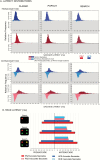Antisaccade Deficits in Schizophrenia Can Be Driven by Attentional Relevance of the Stimuli
- PMID: 32766726
- PMCID: PMC7965078
- DOI: 10.1093/schbul/sbaa106
Antisaccade Deficits in Schizophrenia Can Be Driven by Attentional Relevance of the Stimuli
Abstract
The antisaccade task is considered a test of cognitive control because it creates a conflict between the strong bottom-up signal produced by the cue and the top-down goal of shifting gaze to the opposite side of the display. Antisaccade deficits in schizophrenia are thought to reflect impaired top-down inhibition of the prepotent bottom-up response to the cue. However, the cue is also a highly task-relevant stimulus that must be covertly attended to determine where to shift gaze. We tested the hypothesis that difficulty in overcoming the attentional relevance of the cue, rather than its bottom-up salience, is key in producing impaired performance in people with schizophrenia (PSZ). We implemented 3 versions of the antisaccade task in which we varied the bottom-up salience of the cue while holding its attentional relevance constant. We found that difficulty in performing a given antisaccade task-relative to a prosaccade version using the same stimuli-was largely independent of the cue's bottom-up salience. The magnitude of impairment in PSZ relative to control subjects was also independent of bottom-up salience. The greatest impairment was observed in a version where the cue lacked bottom-up salience advantage over other locations. These results indicate that the antisaccade deficit in PSZ does not reflect an impairment in overcoming bottom-up salience of the cue, but PSZ are instead impaired at overcoming its attentional relevance. This deficit may still indicate an underlying inhibitory control impairment but could also reflect a hyperfocusing of attentional resources on the cue.
Keywords: antisaccade; attention/hyperfocusing; inhibitory control; schizophrenia.
© The Author(s) 2020. Published by Oxford University Press on behalf of the Maryland Psychiatric Research Center. All rights reserved. For permissions, please email: journals.permissions@oup.com.
Figures



Similar articles
-
Failures in top-down control in schizophrenia revealed by patterns of saccadic eye movements.J Abnorm Psychol. 2019 Jul;128(5):415-422. doi: 10.1037/abn0000442. Epub 2019 Jun 13. J Abnorm Psychol. 2019. PMID: 31192637 Free PMC article.
-
Electrophysiological Evidence for Hyperfocusing of Spatial Attention in Schizophrenia.J Neurosci. 2017 Apr 5;37(14):3813-3823. doi: 10.1523/JNEUROSCI.3221-16.2017. Epub 2017 Mar 10. J Neurosci. 2017. PMID: 28283557 Free PMC article.
-
External cues improve visual working memory encoding in the presence of salient distractors in schizophrenia.Psychol Med. 2024 Jul;54(9):1965-1974. doi: 10.1017/S0033291724000059. Epub 2024 Mar 4. Psychol Med. 2024. PMID: 38436135 Free PMC article.
-
Is Attentional Filtering Impaired in Schizophrenia?Schizophr Bull. 2019 Sep 11;45(5):1001-1011. doi: 10.1093/schbul/sbz045. Schizophr Bull. 2019. PMID: 31206163 Free PMC article. Review.
-
The Hyperfocusing Hypothesis: A New Account of Cognitive Dysfunction in Schizophrenia.Schizophr Bull. 2019 Sep 11;45(5):991-1000. doi: 10.1093/schbul/sbz063. Schizophr Bull. 2019. PMID: 31317191 Free PMC article. Review.
Cited by
-
Atypical attentional filtering of visual information in youth with chromosome 22q11.2 deletion syndrome as indexed by event-related potentials.Neuroimage Clin. 2021;32:102877. doi: 10.1016/j.nicl.2021.102877. Epub 2021 Nov 9. Neuroimage Clin. 2021. PMID: 34773799 Free PMC article.
-
Diagnosis of schizophrenia by integrated saccade scores and associations with psychiatric symptoms, and functioning.Medicine (Baltimore). 2024 Oct 11;103(41):e39935. doi: 10.1097/MD.0000000000039935. Medicine (Baltimore). 2024. PMID: 39465854 Free PMC article.
References
-
- Levin S. Frontal lobe dysfunctions in schizophrenia–I. Eye movement impairments. J Psychiatr Res. 1984;18(1):27–55. - PubMed
-
- Barch DM, Carter CS, Braver TS, et al. Selective deficits in prefrontal cortex function in medication-naive patients with schizophrenia. Arch Gen Psychiatry. 2001;58(3):280–288. - PubMed
-
- Munoz DP, Everling S. Look away: the anti-saccade task and the voluntary control of eye movement. Nat Rev Neurosci. 2004;5(3):218. - PubMed

